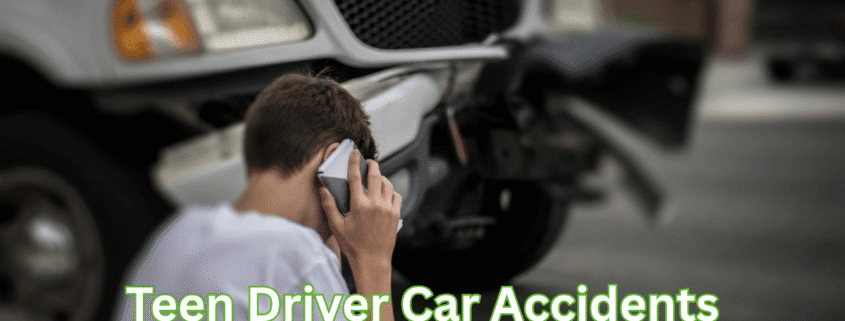Teen Driver Car Accidents: Risks, Rights, and Real Help for Utah Families
No parent wants that late-night call. Yet teen crashes are common, and even a “minor” wreck can change a family’s week or year. You need clear steps, not scare tactics. This guide explains why new drivers face higher risk, what actually causes most teen crashes, how injuries affect school and home life, and how to handle insurance from day one.
You will also see Utah specific rules for young drivers, including passenger limits, phone use, and nighttime driving. If the crash involves injuries, you will learn when a lawyer can help, what fees look like, and how claims really move forward.
Key Info You Should Know
- Teens crash more per mile than adults.
- Night driving multiplies risk quickly.
- Friends in the car raise crash odds.
- Phones and push alerts wreck focus.
- Utah limits passengers and late hours.
- See a doctor after any impact.
- Save photos, reports, and bills.
- Keep insurance talks short and factual.
Why do teen drivers face higher crash risks?
The experience gap
New drivers have not logged enough hours to read traffic the way older drivers do. They miss subtle cues, like a vehicle drifting inside a lane or a brake light two cars ahead. National safety data shows teens crash far more often per mile than adults, and the risk spikes at night. The Insurance Institute for Highway Safety reports teen crash and death rates per mile that are several times higher than older drivers, with nighttime risk especially high. That pattern holds year after year.
Night and low light
Headlights shorten what drivers can see and slow reaction time. Teens are still building hazard detection skills, so darkness makes judgment calls tougher. The CDC also notes teen fatal crash rates at night are several times higher than adults. Weekends add risk as traffic is faster and outings run late.
Passengers and pressure
A car full of friends raises distraction. Even quiet laughter pulls eyes from the road for a second or two. The CDC has long noted that each additional teen passenger increases crash odds for an unsupervised teen driver.
The phone problem
Alerts, playlists, and navigation add constant temptation. In real in-car video research of teen crashes, distraction showed up in a large share of serious incidents. That matches what many parents see every day.
What helps now?
Practice often in short sessions. Adding rain, night, freeway, and city streets with a calm parent in the passenger seat is the perfect recipe for a ride. Ensure that your phone is kept in the glove compartment. Set clear limits on late driving and who rides along during the first months.
Common causes of teen driver crashes
Teenage drivers rarely get into crashes out of nowhere. Parents and experts usually know the patterns well already. It’s common for young drivers to end up in wrecks.
Here are some common causes of teen driver car crashes.
- Distraction: Texts, snaps, and group chats are top of the list reasons of distraction that lead to crashes. Even a quick glance can eat three or four seconds, which is enough to miss a sudden stop. Passenger chatter and reaching for items inside the car also rank high in teen crash videos.
- Speed and following too closely: Teens often misjudge distance. They tailgate without meaning to and do not leave a safety cushion. In traffic, one brake tap causes a chain reaction.
- Night time blunders: Darkness hides pedestrians and cyclists. The fatigue sets in after practice, games, or late shifts. The CDC urges families to limit night driving during the first six months after licensing.
- Inexperience in bad weather: Rain, slush, and snow change everything. New drivers rarely feel how long it takes to stop on wet asphalt. Hydroplaning surprises them.
- Gaps and right-of-way: Many teen crashes involve turning across traffic or misreading right-of-way at complex intersections. Extra practice on left turns and four-way stops helps.
Utah crash dashboards show injury and fatal data updated from police reports. The proportion of teens who are licensed drivers is overrepresented, which is in line with national trends. The state’s public dashboards provide families with information about trends for counties and types of roads.
Simple, proven steps parents can use to reduce teen car crash risk
To maintain a teen driving safety, parents play a greater role. It’s more than most people realize. As a parent, you can exert a lot of influence over how your teen drives. It includes the habits you set and the limits you enforce. You can make every trip safer by taking small and careful steps.
Follow these steps:
1 – Start with a written agreement
Put rules in plain words. No phone use while moving. Use seat belts on every trip. Obey limits for passengers and late-night driving. Share the reasons. Update the rules as your teen gains experience.
2 – Practice regularly
Short, focused drives build skill faster than one long trip. Mix in rain, dusk, night, and highway merges. Talk through what you see. Ask your teen to call out hazards as they appear.
3 – Use tech wisely
Many phones and vehicles offer drive mode to silence notifications. Some family plans let you block notifications while the car is moving. The goal is to remove temptation.
4 – Pick a safe vehicle
Heavier cars with strong crash ratings and modern safety tech protect new drivers. In addition to its safety ratings, IIHS publishes a list of affordable vehicles that are safe for teens. Check ratings before buying.
Quick checklist:
- No phone while the car is moving.
- One friend at most until skills grow.
- Home before 10 on school nights.
- Buckle up, all seats, all trips.
- Practice in the rain and after dark with a parent.
- Review one dash-cam or traffic clip together each week and discuss.
Teen car crash legal timelines and why they matter in Utah
In many Utah injury cases, you generally have up to four years to file a lawsuit. Some claims have shorter periods, including claims against government entities and certain malpractice claims.
Utah law looks at everyone’s share of blame. If your teen is less than 50% at fault, damages can still be recovered but reduced by that percentage. If the fault is 50% or more, recovery may be barred. This is why careful evidence collection matters.
Good documentation drives fair outcomes. Keep medical notes, imaging, therapy plans, and school letters. Save pay stubs showing lost time and any mileage to appointments.
If injuries are more than bumps and bruises, or if fault is in dispute, a short consultation with an experienced car accident lawyer can prevent avoidable mistakes. Bring your folder of records to make that consultation useful.
Hire the best car accident lawyer in Utah for teen crashes
In Utah, cases move through specific rules, forms, and deadlines. A local personal injury attorney knows the judges and claims adjusters. Also, he knows better what evidence tends to carry weight. It saves time and reduces back-and-forth with insurers.
What a good teen car accident lawyer actually does?
They review the police report, interview witnesses, gather camera footage, and work with doctors to understand both current and future care. They calculate lost time from work for a parent and school impacts for a teen.
Contact Chris Cockayne and his team at Cockayne Law
Families who want straight talk often look for someone who explains things in easy to understand words. That is what clients say they like about Chris Cockayne and his team. They focus on clear next steps, quick updates, and realistic timelines. If a case can settle fairly, they negotiate hard. As part of preparation for trial, they prepare the teen and his or her family so there won’t be any surprises.
Final Thoughts
You cannot remove every risk from driving, but you can cut it down. Establish clear rules, keep phones out of reach, and practice often in real conditions. If a crash happens, focus on health first. Then document the scene, bills, and time away from school or work. Keep insurance calls short and factual.
If injuries are serious or fault is disputed, talk with a car accident lawyer in Utah who knows how teen cases move in this state. Healing takes time, and the paper trail can feel heavy. Keep the lines open with your teen, and celebrate each safe mile.
FAQs
Is a medical check needed if my teen feels fine?
Yes. A concussion, whiplash, or internal injury may appear later. A same day or next day visit documents symptoms and guides care. Follow medical advice closely and save every discharge paper and prescription label.
Do teens really face higher risk at night?
Yes. Data shows teen fatal crash rates are several times higher at night compared to day. A parent should help with early curfews and practice after dark with their help. Keep weekend nights simple during the first months.
Are phones allowed for teen drivers in Utah?
There are narrow exceptions to the general rule that drivers under 18 cannot use a phone while driving. Distractions can occur even with hands-free technology. Best practice is to keep the phone out of reach until parked.
How long do we have to bring a Utah injury case?
Many Utah personal injury cases allow up to four years, but some have shorter limits, especially claims against government entities or malpractice claims. Ask a lawyer how the timelines apply to your facts.
What if my teen is partly at fault?
Utah uses modified comparative fault. If your teen is less than 50% at fault, recovery can still be possible but reduced by that share. At 50% or more, recovery may be barred. Evidence and records matter a lot.









